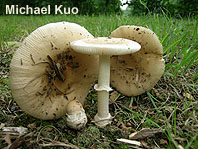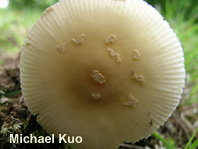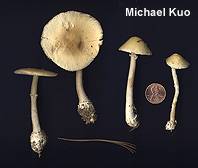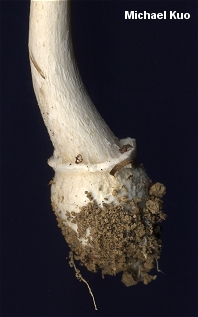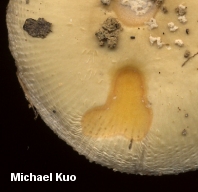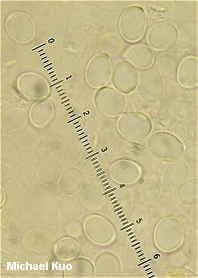| Major Groups > Gilled Mushrooms > Pale-Spored > Amanita > Amanita russuloides |

|
Amanita russuloides [ Basidiomycetes > Agaricales > Amanitaceae > Amanita . . . ] by Michael Kuo North American mycological pioneer Charles Peck thought this mushroom looked like a russula--presumably, something like Russula pectinatoides, with a strongly "tuberculate-striate" (simultaneously lined and pimply) cap margin. In this sense Amanita russuloides is definitely russula-like, especially when viewed from the top. Amanita russuloides appears east of the Great Plains, and features a dull yellow to straw colored cap, scattered grayish to whitish warts, a fragile ring that often disappears, and a small basal bulb that often features a collarlike rim. Not a lot separates Amanita russuloides from the North American version of Amanita gemmata--but the latter is apparently limited to western North America. Additionally, the cap of Amanita russuloides turns pinkish orange with KOH while the cap of Amanita gemmata displays a negative reaction; the spores of Amanita russuloides are slightly smaller; Amanita russuloides is, on average, less stocky; and the cap margin of Amanita russuloides is substantially more striate. Amanita russuloides should also be compared with Amanita multisquamosa (cap whitish with a yellowish center, warts more numerous, margin less prominently lined). Description: Ecology: Mycorrhizal with conifers and hardwoods, but especially fond of oaks; often found in grassy areas; growing alone, scattered, or gregariously; summer and fall; possibly widely distributed east of the Great Plains. Cap: 3-9 cm; convex to broadly convex, flat, or shallowly depressed in age; thin-fleshed; sticky when fresh but soon dry; brownish yellow when very young, becoming pale yellow to straw yellow or, in old age, nearly whitish; with a few whitish to grayish warts that often disappear entirely; bald; the margin lined and pimply for 1-3 cm. Gills: Free from the stem or nearly so; white to creamy; crowded or close; short-gills occasional. Stem: 4-9 cm long; 0.5-1.5 cm thick; tapering slightly to the apex; whitish; bald or finely hairy; whitish, discoloring brownish; with a fragile whitish ring that can appear fairly high on the stem or nearly at the bottom and often disappears entirely; terminating in a small basal bulb; with fragile white volval remnants that form a few vague rings or, more often, a collarlike rim. Flesh: White; unchanging. Odor: Not distinctive. Chemical Reactions: KOH on cap surface orange to pinkish orange. Spore Print: White. Microscopic Features: Spores 8-10.5 x 5.5-8 µ; smooth; broadly elliptical; inamyloid. Basidia 4-spored; without clamps. Pileipellis an ixocutis of elements 2.5-8 µ wide. Lamellar trama bilateral; subhymenium cellular. REFERENCES: (Peck, 1873) Saccardo, 1887. (Murrill, 1913; Beardslee, 1914; Kauffman, 1918; Smith, Smith & Weber, 1979; McNeil, 2006.) Herb. Kuo 08010303, 08180602, 05290704, 06280804, 06041304. This site contains no information about the edibility or toxicity of mushrooms. |
© MushroomExpert.Com |
|
Cite this page as: Kuo, M. (2013, April). Amanita russuloides. Retrieved from the MushroomExpert.Com Web site: http://www.mushroomexpert.com/amanita_russuloides.html |
